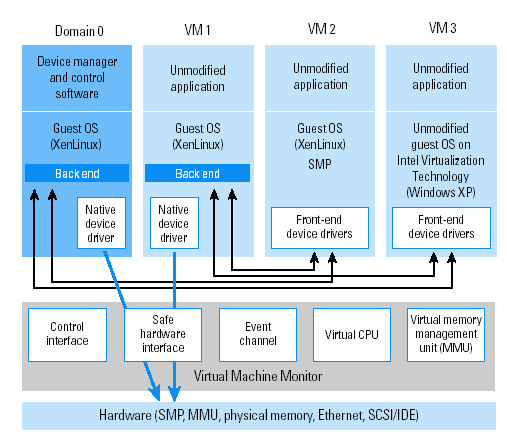Introduction
Citrix Hypervisor, a member of the Citrix Delivery Center product family, allows the rapid deployment of high-performance virtual machines, and the management of their related storage and networking resources from a single management console.
Xen provides fast, secure, open source virtualization that allows multiple operating system instances to run as Xen Virtual Machines or XenVMs on a single physical x86 computer. Xen is based on a para-virtualization technology, which presents an abstraction of the hardware that is similar but not identical to the underlying physical hardware. Para-virtualization techniques require modifications to the guest operating systems that are running on the VMs. As a result, the guest operating systems are aware that they are executing on a VM - allowing for near-native performance.
Figure 1 shows the architecture of Xen server hosting four VMs (Domain 0, VM 1, VM 2, and VM 3). This architecture includes the Xen Virtual Machine Monitor (VMM) or the Xen Hypervisor, which abstracts the underlying physical hardware and provides hardware access for the different virtual machines. Since the Xen hypervisor is installed on the ‘bare metal’, it lies between the physical hardware and the base operating system, and effectively decouples the guest operating systems and the applications executing within from the underlying physical server. Figure 1 shows the special role of the VM called Domain 0 or the control domain. Only the control domain can access the control interface of the VMM, through which other VMs can be created, destroyed, and managed. Management and control software runs in the control domain. Administrators can create virtual machines with special privileges—such as VM 1—that can directly access the hardware through secure interfaces provided by Xen. Administrators can create other virtual machines that can access the physical resources provided by Domain 0’s control and management interface in Xen.

Figure 1 : The architecture of a Citrix Hypervisor
In this example, the guest operating systems in VM 1 and in VM 2 are modified to run above Xen and also have Xen-aware drivers to enable high performance. Near-native performance can be achieved through this approach. Unmodified guest operating systems are also supported using new processor extensions from Intel (VT) and AMD (AMD-V).
